Legend of Zelda theme by monomania247
Download: LegendofZelda_2.p3t
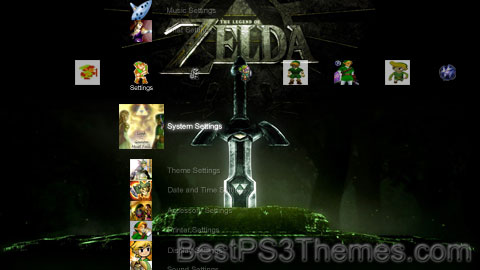
(16 backgrounds, HD only)
Redirect to:
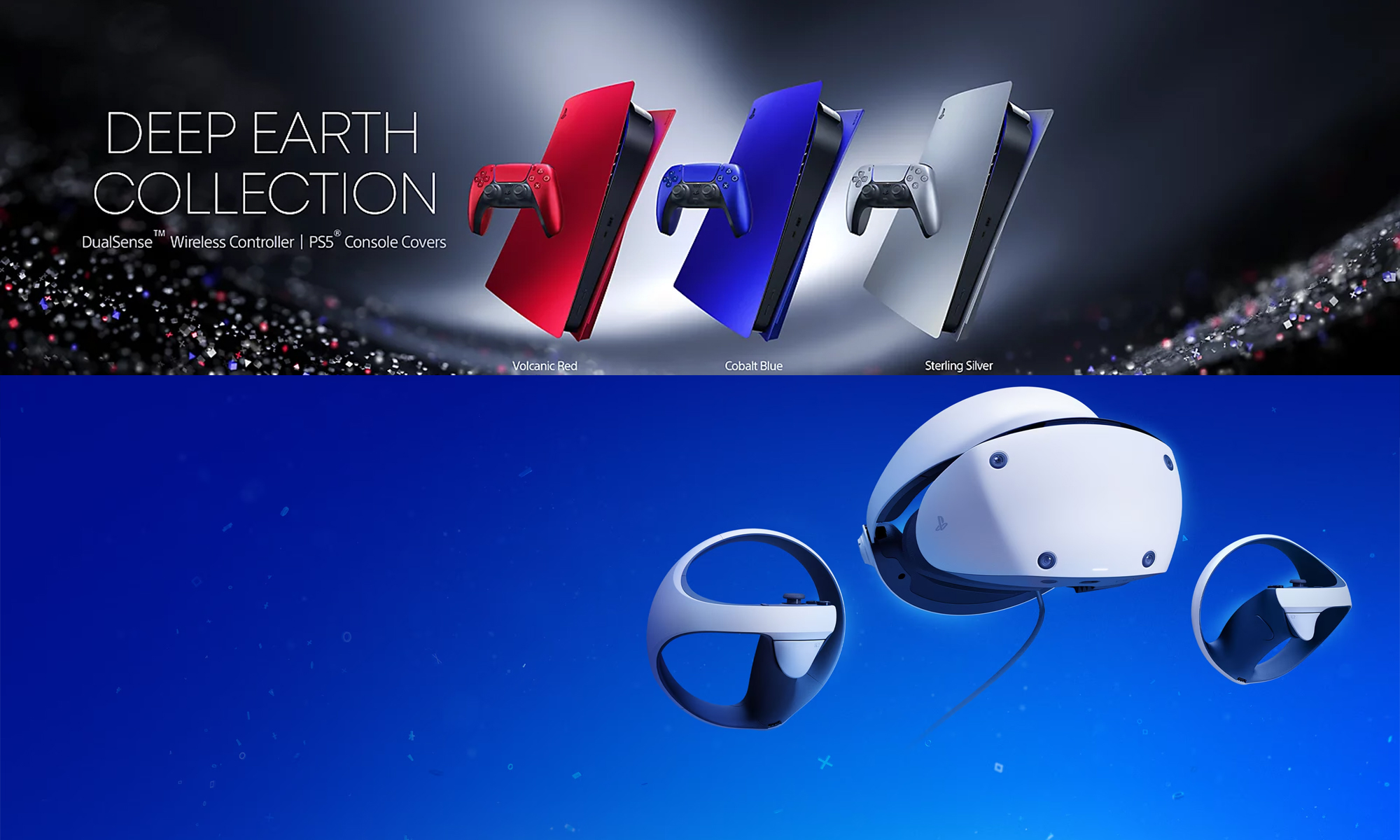
The #1 spot for Playstation themes!
Legend of Zelda theme by monomania247
Download: LegendofZelda_2.p3t

(16 backgrounds, HD only)
Redirect to:
Final Fantasy: Advent Children HD theme by DarkRapture
Download: FinalFantasyAdventChildrenHD.p3t
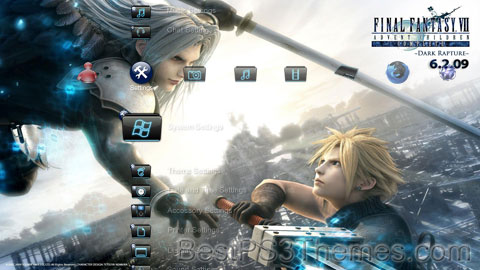
(2 backgrounds, HD only)
P3T Unpacker v0.12
Copyright (c) 2007. Anoop Menon
This program unpacks Playstation 3 Theme files (.p3t) so that you can touch-up an existing theme to your likings or use a certain wallpaper from it (as many themes have multiple). But remember, if you use content from another theme and release it, be sure to give credit!
Download for Windows: p3textractor.zip
Instructions:
Download p3textractor.zip from above. Extract the files to a folder with a program such as WinZip or WinRAR. Now there are multiple ways to extract the theme.
The first way is to simply open the p3t file with p3textractor.exe. If you don’t know how to do this, right click the p3t file and select Open With. Alternatively, open the p3t file and it will ask you to select a program to open with. Click Browse and find p3textractor.exe from where you previously extracted it to. It will open CMD and extract the theme to extracted.[filename]. After that, all you need to do for any future p3t files is open them and it will extract.
The second way is very simple. Just drag the p3t file to p3textractor.exe. It will open CMD and extract the theme to extracted.[filename].
For the third way, first put the p3t file you want to extract into the same folder as p3textractor.exe. Open CMD and browse to the folder with p3extractor.exe. Enter the following:
p3textractor filename.p3t [destination path]Replace filename with the name of the p3t file, and replace [destination path] with the name of the folder you want the files to be extracted to. A destination path is not required. By default it will extract to extracted.filename.
Final Fantasy XIII HD theme by DarkRapture
Download: FinalFantasyXIIIHD.p3t
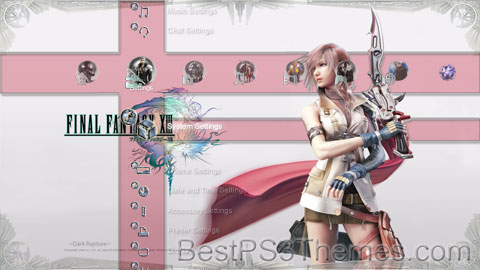
(2 backgrounds)
P3T Unpacker v0.12
Copyright (c) 2007. Anoop Menon
This program unpacks Playstation 3 Theme files (.p3t) so that you can touch-up an existing theme to your likings or use a certain wallpaper from it (as many themes have multiple). But remember, if you use content from another theme and release it, be sure to give credit!
Download for Windows: p3textractor.zip
Instructions:
Download p3textractor.zip from above. Extract the files to a folder with a program such as WinZip or WinRAR. Now there are multiple ways to extract the theme.
The first way is to simply open the p3t file with p3textractor.exe. If you don’t know how to do this, right click the p3t file and select Open With. Alternatively, open the p3t file and it will ask you to select a program to open with. Click Browse and find p3textractor.exe from where you previously extracted it to. It will open CMD and extract the theme to extracted.[filename]. After that, all you need to do for any future p3t files is open them and it will extract.
The second way is very simple. Just drag the p3t file to p3textractor.exe. It will open CMD and extract the theme to extracted.[filename].
For the third way, first put the p3t file you want to extract into the same folder as p3textractor.exe. Open CMD and browse to the folder with p3extractor.exe. Enter the following:
p3textractor filename.p3t [destination path]Replace filename with the name of the p3t file, and replace [destination path] with the name of the folder you want the files to be extracted to. A destination path is not required. By default it will extract to extracted.filename.
Smallville KRYPTIC V1.0 theme by Montage Mik
Download: SmallvilleKRYPTIC.p3t
A World Different From Mine theme by darkliam
Download: AWorldDifferentFromMine.p3t
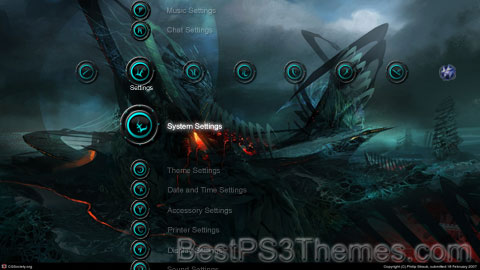
(6 backgrounds)
P3T Unpacker v0.12
Copyright (c) 2007. Anoop Menon
This program unpacks Playstation 3 Theme files (.p3t) so that you can touch-up an existing theme to your likings or use a certain wallpaper from it (as many themes have multiple). But remember, if you use content from another theme and release it, be sure to give credit!
Download for Windows: p3textractor.zip
Instructions:
Download p3textractor.zip from above. Extract the files to a folder with a program such as WinZip or WinRAR. Now there are multiple ways to extract the theme.
The first way is to simply open the p3t file with p3textractor.exe. If you don’t know how to do this, right click the p3t file and select Open With. Alternatively, open the p3t file and it will ask you to select a program to open with. Click Browse and find p3textractor.exe from where you previously extracted it to. It will open CMD and extract the theme to extracted.[filename]. After that, all you need to do for any future p3t files is open them and it will extract.
The second way is very simple. Just drag the p3t file to p3textractor.exe. It will open CMD and extract the theme to extracted.[filename].
For the third way, first put the p3t file you want to extract into the same folder as p3textractor.exe. Open CMD and browse to the folder with p3extractor.exe. Enter the following:
p3textractor filename.p3t [destination path]Replace filename with the name of the p3t file, and replace [destination path] with the name of the folder you want the files to be extracted to. A destination path is not required. By default it will extract to extracted.filename.
Street Fighter Akuma – Khouba theme by Ron Pinkney
Download: StreetFighterAkumaKhouba.p3t
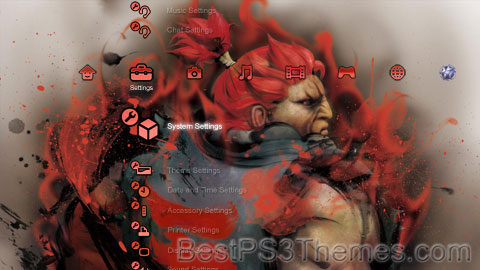
(4 backgrounds)
P3T Unpacker v0.12
Copyright (c) 2007. Anoop Menon
This program unpacks Playstation 3 Theme files (.p3t) so that you can touch-up an existing theme to your likings or use a certain wallpaper from it (as many themes have multiple). But remember, if you use content from another theme and release it, be sure to give credit!
Download for Windows: p3textractor.zip
Instructions:
Download p3textractor.zip from above. Extract the files to a folder with a program such as WinZip or WinRAR. Now there are multiple ways to extract the theme.
The first way is to simply open the p3t file with p3textractor.exe. If you don’t know how to do this, right click the p3t file and select Open With. Alternatively, open the p3t file and it will ask you to select a program to open with. Click Browse and find p3textractor.exe from where you previously extracted it to. It will open CMD and extract the theme to extracted.[filename]. After that, all you need to do for any future p3t files is open them and it will extract.
The second way is very simple. Just drag the p3t file to p3textractor.exe. It will open CMD and extract the theme to extracted.[filename].
For the third way, first put the p3t file you want to extract into the same folder as p3textractor.exe. Open CMD and browse to the folder with p3extractor.exe. Enter the following:
p3textractor filename.p3t [destination path]Replace filename with the name of the p3t file, and replace [destination path] with the name of the folder you want the files to be extracted to. A destination path is not required. By default it will extract to extracted.filename.
Halo 3 MLG v1.50 theme by InSaN3_GoDLiK3
Download: Halo3MLG.p3t

(8 backgrounds HD, 2 SD)
P3T Unpacker v0.12
Copyright (c) 2007. Anoop Menon
This program unpacks Playstation 3 Theme files (.p3t) so that you can touch-up an existing theme to your likings or use a certain wallpaper from it (as many themes have multiple). But remember, if you use content from another theme and release it, be sure to give credit!
Download for Windows: p3textractor.zip
Instructions:
Download p3textractor.zip from above. Extract the files to a folder with a program such as WinZip or WinRAR. Now there are multiple ways to extract the theme.
The first way is to simply open the p3t file with p3textractor.exe. If you don’t know how to do this, right click the p3t file and select Open With. Alternatively, open the p3t file and it will ask you to select a program to open with. Click Browse and find p3textractor.exe from where you previously extracted it to. It will open CMD and extract the theme to extracted.[filename]. After that, all you need to do for any future p3t files is open them and it will extract.
The second way is very simple. Just drag the p3t file to p3textractor.exe. It will open CMD and extract the theme to extracted.[filename].
For the third way, first put the p3t file you want to extract into the same folder as p3textractor.exe. Open CMD and browse to the folder with p3extractor.exe. Enter the following:
p3textractor filename.p3t [destination path]Replace filename with the name of the p3t file, and replace [destination path] with the name of the folder you want the files to be extracted to. A destination path is not required. By default it will extract to extracted.filename.
God Of War 3 HD theme by Jubei808
Download: GodOfWar3HD.p3t
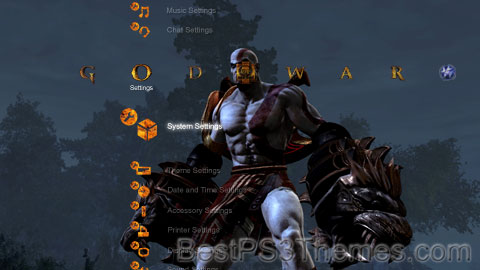
(16 backgrounds, HD only)
P3T Unpacker v0.12
Copyright (c) 2007. Anoop Menon
This program unpacks Playstation 3 Theme files (.p3t) so that you can touch-up an existing theme to your likings or use a certain wallpaper from it (as many themes have multiple). But remember, if you use content from another theme and release it, be sure to give credit!
Download for Windows: p3textractor.zip
Instructions:
Download p3textractor.zip from above. Extract the files to a folder with a program such as WinZip or WinRAR. Now there are multiple ways to extract the theme.
The first way is to simply open the p3t file with p3textractor.exe. If you don’t know how to do this, right click the p3t file and select Open With. Alternatively, open the p3t file and it will ask you to select a program to open with. Click Browse and find p3textractor.exe from where you previously extracted it to. It will open CMD and extract the theme to extracted.[filename]. After that, all you need to do for any future p3t files is open them and it will extract.
The second way is very simple. Just drag the p3t file to p3textractor.exe. It will open CMD and extract the theme to extracted.[filename].
For the third way, first put the p3t file you want to extract into the same folder as p3textractor.exe. Open CMD and browse to the folder with p3extractor.exe. Enter the following:
p3textractor filename.p3t [destination path]Replace filename with the name of the p3t file, and replace [destination path] with the name of the folder you want the files to be extracted to. A destination path is not required. By default it will extract to extracted.filename.
Tux theme by fubarmalone
Download: Tux_3.p3t
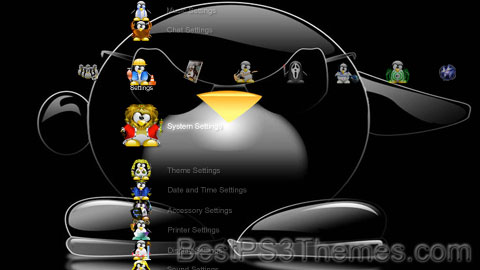
(7 backgrounds, HD only)
Redirect to:
This page is a redirect. The following categories are used to track and monitor this redirect:
|
Walt Disney theme by fubarmalone
Download: WaltDisney.p3t
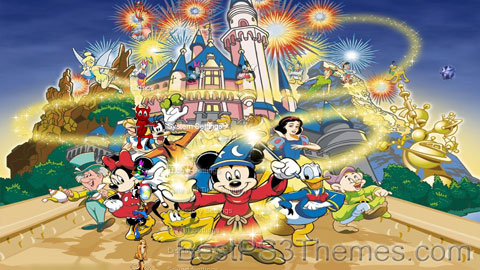
(8 backgrounds, HD only)
Walt Disney | |
|---|---|
 Disney in 1946 | |
| Born | December 5, 1901 Chicago, Illinois, U.S. |
| Died | December 15, 1966 (aged 65) Burbank, California, U.S. |
| Occupations |
|
| Title | President of The Walt Disney Company[1] |
| Spouse | |
| Children | 2, including Diane Disney Miller |
| Relatives | Disney family |
| Awards | |
| Signature | |
 | |
Walter Elias Disney (/ˈdɪzni/;[2] December 5, 1901 – December 15, 1966) was an American animator, film producer, voice actor, and entrepreneur. A pioneer of the American animation industry, he introduced several developments in the production of cartoons. As a film producer, he holds the record for most Academy Awards earned and nominations by an individual. He was presented with two Golden Globe Special Achievement Awards and an Emmy Award, among other honors. Several of his films are included in the National Film Registry by the Library of Congress and have also been named as some of the greatest films ever by the American Film Institute.
Born in Chicago in 1901, Disney developed an early interest in drawing. He took art classes as a boy and took a job as a commercial illustrator at the age of 18. He moved to California in the early 1920s and set up the Disney Brothers Studio (now The Walt Disney Company) with his brother Roy. With Ub Iwerks, he developed the character Mickey Mouse in 1928, his first highly popular success; he also provided the voice for his creation in the early years. As the studio grew, he became more adventurous, introducing synchronized sound, full-color three-strip Technicolor, feature-length cartoons and technical developments in cameras. The results, seen in features such as Snow White and the Seven Dwarfs (1937), Pinocchio, Fantasia (both 1940), Dumbo (1941), and Bambi (1942), furthered the development of animated film. New animated and live-action films followed after World War II, including the critically successful Cinderella (1950), Sleeping Beauty (1959) and Mary Poppins (1964), the last of which received five Academy Awards.
In the 1950s, Disney expanded into the theme park industry, and in July 1955 he opened Disneyland in Anaheim, California. To fund the project he diversified into television programs, such as Walt Disney's Disneyland and The Mickey Mouse Club. He was also involved in planning the 1959 Moscow Fair, the 1960 Winter Olympics, and the 1964 New York World's Fair. In 1965, he began development of another theme park, Disney World, the heart of which was to be a new type of city, the "Experimental Prototype Community of Tomorrow" (EPCOT). Disney was a heavy smoker throughout his life and died of lung cancer in 1966 before either the park or the EPCOT project were completed.
Disney was a shy, self-deprecating and insecure man in private but adopted a warm and outgoing public persona. He had high standards and high expectations of those with whom he worked. Although there have been accusations that he was racist or antisemitic, they have been contradicted by many who knew him. Historiography of Disney has taken a variety of perspectives, ranging from views of him as a purveyor of homely patriotic values to being a representative of American cultural imperialism. Widely considered to be one of the most influential cultural figures of the 20th century, Disney remains an important presence in the history of animation and in the cultural history of the United States, where he is acknowledged as a national cultural icon. His film work continues to be shown and adapted, the Disney theme parks have grown in size and number around the world and his company has grown to become one of the world's largest mass media and entertainment conglomerates.
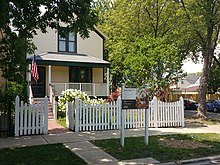
Disney was born on December 5, 1901, at 1249 Tripp Avenue, in Chicago's Hermosa neighborhood.[b] He was the fourth son of Elias Disney—born in the Province of Canada, to Irish parents—and Flora (née Call), an American of German and English descent.[4][5][c] Aside from Walt, Elias and Flora's sons were Herbert, Raymond and Roy; and the couple had a fifth child, Ruth, in December 1903.[8] In 1906, when Disney was four, the family moved to a farm in Marceline, Missouri, where his uncle Robert had just purchased land. In Marceline, Disney developed his interest in drawing when he was paid to draw the horse of a retired neighborhood doctor.[9] Elias was a subscriber to the Appeal to Reason newspaper, and Disney practiced drawing by copying the front-page cartoons of Ryan Walker.[10] He also began to develop an ability to work with watercolors and crayons.[5] He lived near the Atchison, Topeka and Santa Fe Railway line and became enamored with trains.[11] He and his younger sister Ruth started school at the same time at the Park School in Marceline in late 1909.[12] The Disney family were active members of a Congregational church.[13]
In 1911, the Disneys moved to Kansas City, Missouri.[14] There, Disney attended the Benton Grammar School, where he met fellow-student Walter Pfeiffer, who came from a family of theatre fans and introduced him to the world of vaudeville and motion pictures. Before long, Disney was spending more time at the Pfeiffers' house than at home.[15] Elias had purchased a newspaper delivery route for The Kansas City Star and Kansas City Times. Disney and his brother Roy woke up at 4:30 every morning to deliver the Times before school and repeated the round for the evening Star after school. The schedule was exhausting, and Disney often received poor grades after falling asleep in class, but he continued his paper route for more than six years.[16] He attended Saturday courses at the Kansas City Art Institute and also took a correspondence course in cartooning.[5][17]
In 1917, Elias bought stock in a Chicago jelly producer, the O-Zell Company, and moved back to the city with his family.[18] Disney enrolled at McKinley High School and became the cartoonist of the school newspaper, drawing patriotic pictures about World War I;[19][20] he also took night courses at the Chicago Academy of Fine Arts.[21] In mid-1918, he attempted to join the United States Army to fight the Germans, but he was rejected as too young. After forging the date of birth on his birth certificate, he joined the Red Cross in September 1918 as an ambulance driver. He was shipped to France but arrived in November, after the armistice.[22] He drew cartoons on the side of his ambulance for decoration and had some of his work published in the army newspaper Stars and Stripes.[23] He returned to Kansas City in October 1919,[24] where he worked as an apprentice artist at the Pesmen-Rubin Commercial Art Studio, where he drew commercial illustrations for advertising, theater programs and catalogs, and befriended fellow artist Ub Iwerks.[25]

In January 1920, as Pesmen-Rubin's revenue declined after Christmas, Disney, aged 18, and Iwerks were laid off. They started their own business, the short-lived Iwerks-Disney Commercial Artists.[26] Failing to attract many customers, Disney and Iwerks agreed that Disney should leave temporarily to earn money at the Kansas City Film Ad Company, run by A. V. Cauger; the following month Iwerks, who was not able to run their business alone, also joined.[27] The company produced commercials using the cutout animation technique.[28] Disney became interested in animation, although he preferred drawn cartoons such as Mutt and Jeff and Max Fleischer's Out of the Inkwell. With the assistance of a borrowed book on animation and a camera, he began experimenting at home.[29][d] He came to the conclusion that cel animation was more promising than the cutout method.[e] Unable to persuade Cauger to try cel animation at the company, Disney opened a new business with a co-worker from the Film Ad Co, Fred Harman.[31] Their main client was the local Newman Theater, and the short cartoons they produced were sold as "Newman's Laugh-O-Grams".[32] Disney studied Paul Terry's Aesop's Fables as a model, and the first six "Laugh-O-Grams" were modernized fairy tales.[33]
In May 1921, the success of the "Laugh-O-Grams" led to the establishment of Laugh-O-Gram Studio, for which he hired more animators, including Fred Harman's brother Hugh, Rudolf Ising and Iwerks.[34] The Laugh-O-Grams cartoons did not provide enough income to keep the company solvent, so Disney started production of Alice's Wonderland—based on Alice's Adventures in Wonderland—which combined live action with animation; he cast Virginia Davis in the title role.[35] The result, a 12½-minute, one-reel film, was completed too late to save Laugh-O-Gram Studio, which went into bankruptcy in 1923.[36]
Disney moved to Hollywood in July 1923 at 21 years old. Although New York was the center of the cartoon industry, he was attracted to Los Angeles because his brother Roy was convalescing from tuberculosis there,[37] and he hoped to become a live-action film director.[38] Disney's efforts to sell Alice's Wonderland were in vain until he heard from New York film distributor Margaret J. Winkler. She was losing the rights to both the Out of the Inkwell and Felix the Cat cartoons, and needed a new series. In October, they signed a contract for six Alice comedies, with an option for two further series of six episodes each.[38][39] Disney and his brother Roy formed the Disney Brothers Studio—which later became The Walt Disney Company—to produce the films;[40][41] they persuaded Davis and her family to relocate to Hollywood to continue production, with Davis on contract at $100 a month. In July 1924, Disney also hired Iwerks, persuading him to relocate to Hollywood from Kansas City.[42] In 1926,[43] the first official Walt Disney Studio was established at 2725 Hyperion Avenue; the building was demolished in 1940.[44]
By 1926, Winkler's role in the distribution of the Alice series had been handed over to her husband, the film producer Charles Mintz, although the relationship between him and Disney was sometimes strained.[45] The series ran until July 1927,[46] by which time Disney had begun to tire of it and wanted to move away from the mixed format to all animation.[45][47] After Mintz requested new material to distribute through Universal Pictures, Disney and Iwerks created Oswald the Lucky Rabbit, a character Disney wanted to be "peppy, alert, saucy and venturesome, keeping him also neat and trim".[47][48]
In February 1928, Disney hoped to negotiate a larger fee for producing the Oswald series, but found Mintz wanting to reduce the payments. Mintz had also persuaded many of the artists involved to work directly for him, including Harman, Ising, Carman Maxwell and Friz Freleng. Disney also found out that Universal owned the intellectual property rights to Oswald. Mintz threatened to start his own studio and produce the series himself if Disney refused to accept the reductions. Disney declined Mintz's ultimatum and lost most of his animation staff, except Iwerks, who chose to remain with him.[49][50][f]
To replace Oswald, Disney and Iwerks developed Mickey Mouse, possibly inspired by a pet mouse that Disney had adopted while working in his Laugh-O-Gram studio, although the origins of the character are unclear.[52][g] Disney's original choice of name was Mortimer Mouse, but his wife Lillian thought it too pompous, and suggested Mickey instead.[53][h] Iwerks revised Disney's provisional sketches to make the character easier to animate. Disney, who had begun to distance himself from the animation process,[55] provided Mickey's voice until 1947. In the words of one Disney employee, "Ub designed Mickey's physical appearance, but Walt gave him his soul."[56]
Mickey Mouse first appeared in May 1928 as a single test screening of the short Plane Crazy, but it, and the second feature, The Gallopin' Gaucho, failed to find a distributor.[57] Following the 1927 sensation The Jazz Singer, Disney used synchronized sound on the third short, Steamboat Willie, to create the first post-produced sound cartoon. After the animation was complete, Disney signed a contract with the former executive of Universal Pictures, Pat Powers, to use the "Powers Cinephone" recording system;[58] Cinephone became the new distributor for Disney's early sound cartoons, which soon became popular.[59]
To improve the quality of the music, Disney hired the professional composer and arranger Carl Stalling, on whose suggestion the Silly Symphony series was developed, providing stories through the use of music; the first in the series, The Skeleton Dance (1929), was drawn and animated entirely by Iwerks. Also hired at this time were several artists, both local and from New York.[60] Both the Mickey Mouse and Silly Symphonies series were successful, but Disney and his brother felt they were not receiving their rightful share of profits from Powers. In 1930, Disney tried to trim costs from the process by urging Iwerks to abandon the practice of drawing every frame individually in favor of the more efficient technique of drawing key poses and letting assistants sketch the inbetween poses. Disney asked Powers for an increase in payments for the cartoons. Powers refused and signed Iwerks to work for him; Stalling resigned shortly afterwards, thinking that without Iwerks, the Disney Studio would close.[61] Disney had a nervous breakdown in October 1931—which he blamed on the machinations of Powers and his own overwork—so he and Lillian took an extended holiday to Cuba and a cruise to Panama to recover.[62]
With the loss of Powers as distributor, Disney studios signed a contract with Columbia Pictures to distribute the Mickey Mouse cartoons, which became increasingly popular, including internationally.[63][64][i] Disney and his crew also introduced new cartoon stars like Pluto in 1930, Goofy in 1932 and Donald Duck in 1934.[65] Always keen to embrace new technology and encouraged by his new contract with United Artists, Disney filmed Flowers and Trees (1932) in full-color three-strip Technicolor;[66] he was also able to negotiate a deal giving him the sole right to use the three-strip process until August 31, 1935.[67] All subsequent Silly Symphony cartoons were in color.[68] Flowers and Trees was popular with audiences[69] and won the inaugural Academy Award for best Short Subject (Cartoon) at the 1932 ceremony. Disney had been nominated for another film in that category, Mickey's Orphans, and received an Honorary Award "for the creation of Mickey Mouse".[70][71]
In 1933, Disney produced The Three Little Pigs, a film described by the media historian Adrian Danks as "the most successful short animation of all time".[72] The film won Disney another Academy Award in the Short Subject (Cartoon) category. The film's success led to a further increase in the studio's staff, which numbered nearly 200 by the end of the year.[73] Disney realized the importance of telling emotionally gripping stories that would interest the audience,[74] and he invested in a "story department" separate from the animators, with storyboard artists who would detail the plots of Disney's films.[75]

By 1934, Disney had become dissatisfied with producing cartoon shorts,[65] and believed a feature-length cartoon would be more profitable.[76] The studio began the four-year production of Snow White and the Seven Dwarfs, based on the fairy tale. When news leaked out about the project, many in the film industry predicted it would bankrupt the company; industry insiders nicknamed it "Disney's Folly".[77] The film, which was the first animated feature made in full color and sound, cost $1.5 million to produce—three times over budget.[78] To ensure the animation was as realistic as possible, Disney sent his animators on courses at the Chouinard Art Institute;[79] he brought animals into the studio and hired actors so that the animators could study realistic movement.[80] To portray the changing perspective of the background as a camera moved through a scene, Disney's animators developed a multiplane camera which allowed drawings on pieces of glass to be set at various distances from the camera, creating an illusion of depth. The glass could be moved to create the impression of a camera passing through the scene. The first work created on the camera—a Silly Symphony called The Old Mill (1937)—won the Academy Award for Animated Short Film because of its impressive visual power. Although Snow White had been largely finished by the time the multiplane camera had been completed, Disney ordered some scenes be re-drawn to use the new effects.[81]
Snow White premiered in December 1937 to high praise from critics and audiences. The film became the most successful motion picture of 1938 and by May 1939 its total gross of $6.5 million made it the most successful sound film made to that date.[77][j] Disney won another Honorary Academy Award, which consisted of one full-sized and seven miniature Oscar statuettes.[83][k] The success of Snow White heralded one of the most productive eras for the studio; the Walt Disney Family Museum calls the following years "the 'Golden Age of Animation' ".[84][85] With work on Snow White finished, the studio began producing Pinocchio in early 1938 and Fantasia in November of the same year. Both films were released in 1940, and neither perfo